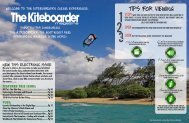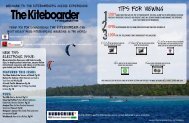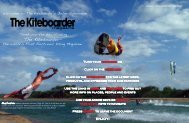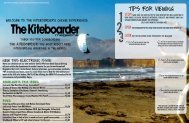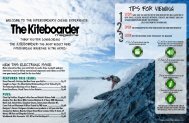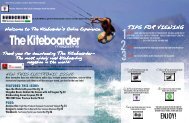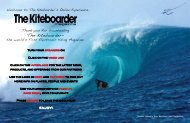Safety When Launching and Landing - The Kiteboarder Magazine
Safety When Launching and Landing - The Kiteboarder Magazine
Safety When Launching and Landing - The Kiteboarder Magazine
Create successful ePaper yourself
Turn your PDF publications into a flip-book with our unique Google optimized e-Paper software.
Pivec <strong>and</strong> Top Hat give up the goods on being successful in the waves<br />
spot for awhile before you go<br />
out. If you have experience surfing,<br />
then you probably already<br />
have the skills. Try to adapt<br />
some of the concepts to your<br />
kiting style. Watch the best guys<br />
at your beach <strong>and</strong> check out surf<br />
videos to imitate body position<br />
through moves. Try not to get<br />
yanked down the wave by your<br />
kite. Using the right size kite is<br />
key. Think smooth <strong>and</strong> fluid.<br />
Q: What wind conditions/directions<br />
are best in relationship to<br />
wave direction?<br />
A: Today’s kites make it safe to<br />
fly in almost all conditions, even<br />
in offshore winds as long as you<br />
have boat back up. Never go out<br />
further than you are willing to<br />
swim in. If it can go wrong, it will<br />
go wrong.<br />
Q: Should I ride overpowered<br />
or underpowered?<br />
A: It is always safer to go<br />
underpowered. A surfboard’s<br />
buoyancy replaces the need for<br />
a larger size kite. This allows you<br />
to fly the kite without losing edge<br />
control, which is a very important<br />
key in riding big waves.<br />
Overpowered kiting is best for<br />
freestyle <strong>and</strong> big jumps.<br />
Q: How do I best position myself<br />
to catch a wave, so I’m not<br />
riding whitewash?<br />
A: As in everything it takes time<br />
<strong>and</strong> with practice, it will come. It<br />
does help to enter the wave either<br />
before or at the peak of the<br />
wave (peak meaning where the<br />
<strong>The</strong> <strong>Kiteboarder</strong> 42<br />
wave is at it highest when first<br />
forming). With each wave should<br />
come more knowledge.<br />
Q: Where should I enter the<br />
wave when first starting waveriding?<br />
A: <strong>The</strong>re are many types of<br />
waves. As a rule of thumb, it is<br />
always good to start at the start<br />
of it or the peak.<br />
Q: Where should I position my<br />
kite to start a bottom turn?<br />
A: It really depends on what kite<br />
you fly. Bow users will keep their<br />
kite in one spot <strong>and</strong> just sheet in<br />
<strong>and</strong> out of the loop, hardly moving<br />
the kite. This is why they use<br />
a bigger kite than a C-kite rider.<br />
A C-kite rider flies their kite more<br />
generating more power from<br />
the wind window. Usually, you<br />
send your kite back towards the<br />
wave before you even go into<br />
your bottom turn. <strong>The</strong>n, when<br />
going for your top turn, your<br />
kite should already be facing<br />
the shore putting it into the right<br />
position to do two or more turns<br />
without moving it. <strong>The</strong>n, you do<br />
it all over again.<br />
Q: How do you keep from<br />
getting overpowered when<br />
unhooked?<br />
A: Make sure your kite size is<br />
not too big. If you are surfing<br />
towards your kite, you should<br />
never get yanked. Your body<br />
positioning <strong>and</strong> arm should act<br />
as a shock absorber moving with<br />
the flow of your riding. Be one<br />
with your kite.<br />
Ben Wilson fades into a carving cutback<br />
dragging his h<strong>and</strong> with style.<br />
Lens: Ben Kottke<br />
Q: In general, where should my<br />
kite be when riding a wave?<br />
A: This is tough to answer in only<br />
a few sentences. <strong>The</strong> best tip is<br />
to watch some guys ride waves<br />
at your local beach or in a video.<br />
A lot of it is trial <strong>and</strong> error. As you<br />
get better, you will become more<br />
aggressive with the kite.<br />
Q: What is the trick to riding<br />
switch tack?<br />
A: Start practicing switch on a<br />
wakeboard or twin tip just to get<br />
use to transferring you weight<br />
the right way. <strong>The</strong>n, adapt it to<br />
a surfboard. Your natural stance<br />
will always be stronger. If you<br />
put the time in you will soon<br />
become a switch master. Starting<br />
on flat water doing little turns<br />
is a great way to learn the basics.<br />
As soon as you feel confident,<br />
adapt it to the surf.<br />
Q: Are their any other things I<br />
should know?<br />
A: Waves are the future <strong>and</strong> any<br />
average kiteboarder can get into<br />
the surf whether hooked or unhooked,<br />
strapped or strapless. In<br />
the end, it is all about having fun.<br />
<strong>The</strong> <strong>Kiteboarder</strong> 43



